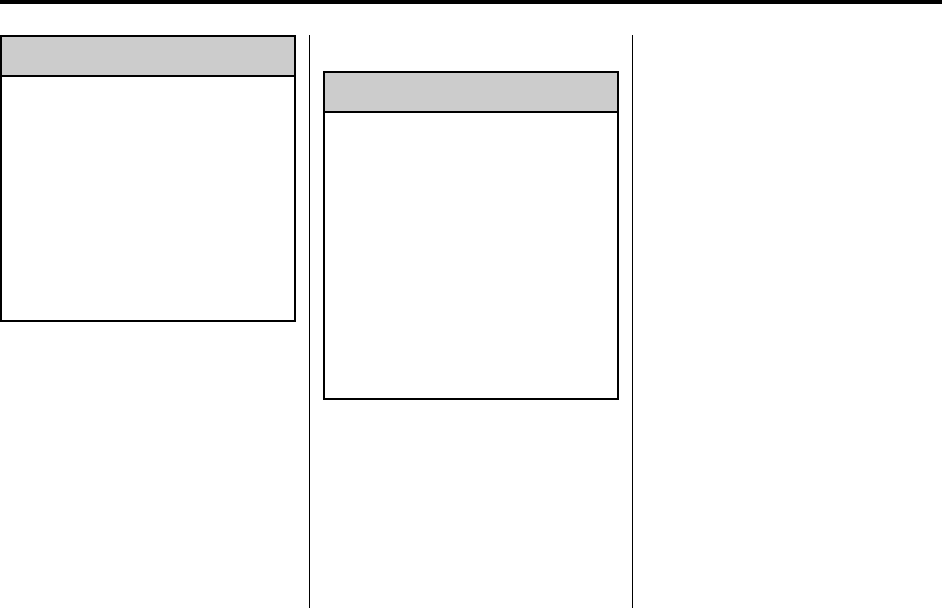Owner's Manual
Table Of Contents
- 2010 Saturn VUE BookTOC
- Introduction
- In Brief
- Keys, Doors and Windows
- Seats and Restraints
- Head Restraints
- Front Seats
- Rear Seats
- Safety Belts
- Airbag System
- Where Are the Airbags?
- When Should an Airbag Inflate?
- What Makes an Airbag Inflate?
- How Does an Airbag Restrain?
- What Will You See After an Airbag Inflates?
- Passenger Sensing System
- Servicing the Airbag-Equipped Vehicle
- Adding Equipment to the Airbag-Equipped Vehicle
- Airbag System Check
- Replacing Airbag System Parts After a Crash
- Child Restraints
- Storage
- Instruments and Controls
- Controls
- Warning Lights, Gages, and Indicators
- Instrument Cluster
- Speedometer
- Odometer
- Trip Odometer
- Tachometer
- Fuel Gage
- Safety Belt Reminders
- Airbag Readiness Light
- Passenger Airbag Status Indicator
- Charging System Light
- Malfunction Indicator Lamp
- Service Vehicle Soon Light
- Brake System Warning Light
- Antilock Brake System (ABS) Warning Light
- All-Wheel-Drive Light
- Power Steering Warning Light
- StabiliTrak® Indicator Light
- Traction Control System (TCS) Warning Light
- Engine Coolant Temperature Warning Light
- Tire Pressure Light
- Engine Oil Pressure Light
- Change Engine Oil Light
- Low Fuel Warning Light
- Security Light
- Reduced Engine Power Light
- High-Beam on Light
- Fog Lamp Light
- Low Washer Fluid Warning Light
- Cruise Control Light
- Door Ajar Light
- Gate Ajar Light
- Information Displays
- Vehicle Messages
- Battery Voltage and Charging Messages
- Brake System Messages
- Compass Messages
- Cruise Control Messages
- Door Ajar Messages
- Engine Cooling System Messages
- Engine Oil Messages
- Engine Power Messages
- Fuel System Messages
- Key and Lock Messages
- Ride Control System Messages
- Airbag System Messages
- Service Vehicle Messages
- Tire Messages
- Transmission Messages
- Vehicle Reminder Messages
- Vehicle Personalization
- Universal Remote System
- Lighting
- Infotainment System
- Climate Controls
- Driving and Operating
- Vehicle Care
- General Information
- Vehicle Checks
- Doing Your Own Service Work
- Hood
- Engine Compartment Overview
- Engine Oil
- Engine Oil Life System
- Automatic Transmission Fluid
- Engine Air Cleaner/Filter
- Cooling System
- Engine Coolant
- Engine Overheating
- Power Steering Fluid
- Washer Fluid
- Brakes
- Brake Fluid
- Battery
- All-Wheel Drive
- Starter Switch Check
- Automatic Transmission Shift Lock Control System Check
- Ignition Transmission Lock Check
- Park Brake and P (Park) Mechanism Check
- Wiper Blade Replacement
- Headlamp Aiming
- Bulb Replacement
- Electrical System
- Wheels and Tires
- Tires
- Tire Sidewall Labeling
- Tire Designations
- Tire Terminology and Definitions
- Tire Pressure
- Tire Pressure for High-Speed Operation
- Tire Pressure Monitor System
- Tire Pressure Monitor Operation
- Tire Inspection
- Tire Rotation
- When It Is Time for New Tires
- Buying New Tires
- Different Size Tires and Wheels
- Uniform Tire Quality Grading
- Wheel Alignment and Tire Balance
- Wheel Replacement
- Tire Chains
- If a Tire Goes Flat
- Tire Changing
- Compact Spare Tire
- Jump Starting
- Towing
- Appearance Care
- Service and Maintenance
- Technical Data
- Customer Information
- Customer Information
- Customer Satisfaction Procedure
- Customer Assistance Offices
- Customer Assistance for Text Telephone (TTY) Users
- Online Owner Center
- GM Mobility Reimbursement Program
- Roadside Assistance Program
- Scheduling Service Appointments
- Courtesy Transportation Program
- Collision Damage Repair
- Service Publications Ordering Information
- Reporting Safety Defects
- Vehicle Data Recording and Privacy
- Customer Information
- Index

Driving and Operating 9-31
{
WARNING
Plugging the cord into an
ungrounded outlet could cause an
electrical shock. Also, the wrong
kind of extension cord could
overheat and cause a fire. You
could be seriously injured. Plug
the cord into a properly grounded
three-prong 110-volt AC outlet.
If the cord will not reach, use a
heavy-duty three-prong extension
cord rated for at least 15 amps.
4. Before starting the engine, be
sure to unplug and store the
cord as it was before to keep it
away from moving engine parts.
If you do not, it could be
damaged.
The length of time the heater should
remain plugged in depends on
several factors. Ask a dealer/retailer
in the area where you will be
parking the vehicle for the best
advice on this.
Shifting Into Park
{
WARNING
It can be dangerous to get out of
the vehicle if the shift lever is not
fully in P (Park) with the parking
brake firmly set. The vehicle can
roll. If you have left the engine
running, the vehicle can move
suddenly. You or others could be
injured. To be sure the vehicle will
not move, even when you are on
fairly level ground, use the steps
that follow. If you are pulling a
trailer, see Trailer Towing
on
page 9‑56
.
To shift into P (Park):
1. Hold the brake pedal down and
set the parking brake. See
Parking Brake
on page 9‑39
for
more information.
2. Move the shift lever into P (Park)
by holding in the button on the
shift lever and pushing the lever
all the way toward the front of
the vehicle.
3. Turn the ignition key to
LOCK/OFF.










